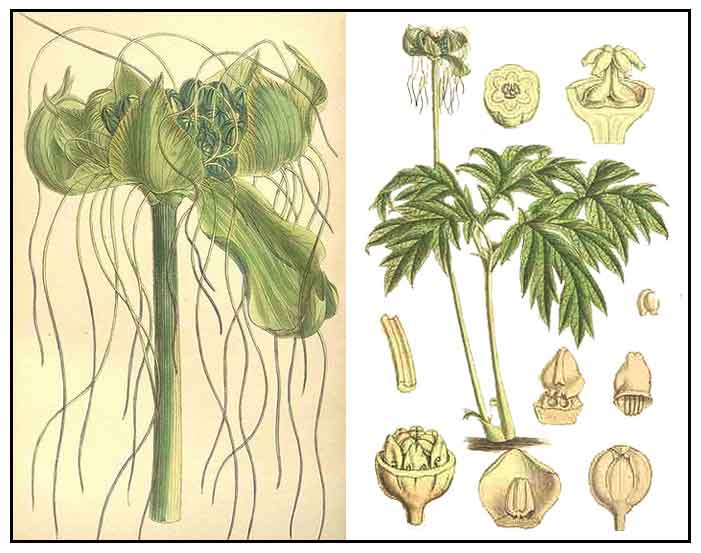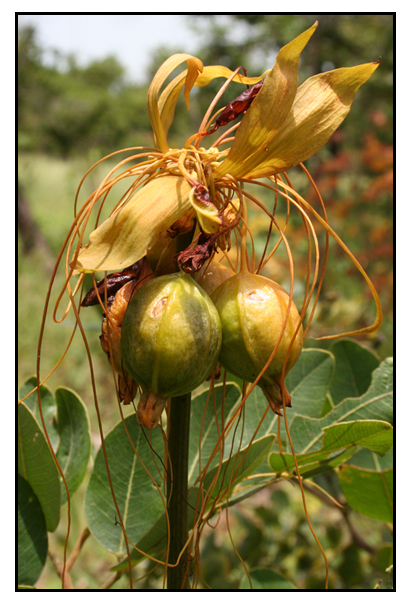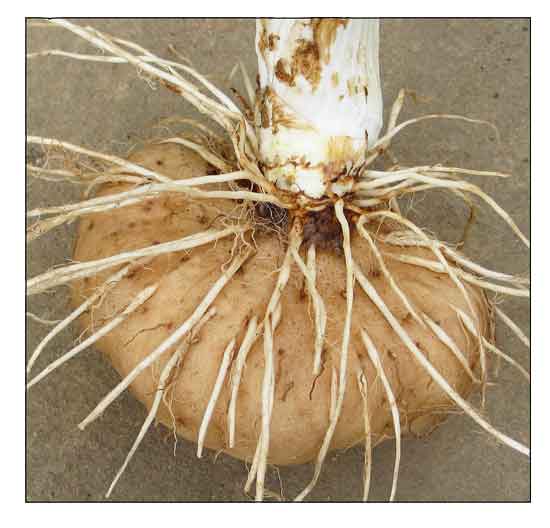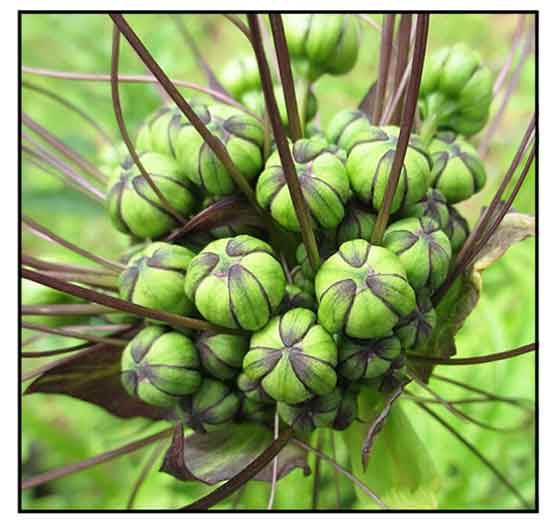
Gen info
- When first published in 1998, Taccaceae was described as a separate family, with a single genus, Tacca. The 2003 revision of the system (APG II) placed the plants in the family Dioscoreaceae. (24)
-
Tacca leontopetalioides is a species of flowering plant in the yam family Dioscoreaceae. Native to Southeast Asia, it was introduced as canoe plants through out the Indo-Pacific tropics by Austronesian peoples during prehistoric times. Now, naturalized in tropical Africa, South Asia, northern Australia, and Oceania.
-
Etymology: The genus name Tacca derives from the Malayan word taka. for Black Bat Plant. The specific epithet leontopetaloides derives from Greek leontos referring to a lion, and petalon, a leaf. (24)
 Botany Botany
• Gau-gau's is a wild perennial herb. Rootstock is tuberous, depressed-rounded, up to 30 centimeters in diameter. Petiole is often nearly 1 meter long, hollow, 1.5 to 2 centimeters in diameter, and striate. Leaves are tripartite, spreading, 1 to 1.5 meters in diameter; the segments 2-fid or irregularly pinnatifid or pinnate at the base, often large, irregularly lobed. Scape is up to 1.4 meters long, hollow, tapering, green, erect, 10- to 40-flowered. Flowers are crowded at the apex, pedicelled, drooping, intermixed with very long, filiform bracts, subtended by 4 to 12 oblong, acuminate, 5 to 7 centimeters long, involucrate leaves. Perianth is green and purplish, about 1 centimeter long. Fruits are ellipsoid or ovoid, smooth, yellowish, 6-ribbed, and 3 to 4 centimeters long.
• Tubers are round, hard and potato-like, with a brown skin and white interior. Leaves are "palmately incised and/or divided into 3-13 lobes, each lobe pinnately divided into numerous smaller ones" Several petioles 17–150 cm (6.7–59.1 in) in length extend from the center of the plant which look like giant celery, on which the large leaves (30–70 cm or 12–28 in long and up to 120 cm or 47 in wide) are attached. Leaf's upper surface has depressed veins, and the under surface is shiny with bold yellow veins. Flowers are borne on tall stalks in greenish-purple umbel-like clusters surrounded by large bracts with long whisker-like appendages, their function is unknown. Each single flower has long, threadlike bracteoles 1 cm long. Fruit emerges from the bracts, each fruit are globular 4–5 cm long, on ripening ripening turning from pale or dark green to pale orange. Each fruit produces many flat, ribbed and yellowish brown seeds 5–8 mm long. (22)
Distribution
- Native to the Philippines.
-
In sandy soils in thickets near the sea throughout the Philippines.
- Native range is Tropical Old World to Pacific. A tuberous geophyte growing primarily in the wet tropical biome. (7)
-
From tropical Africa through Asia to northern Australia.
- Once widely cultivated in the tropics for its edible root.
 Constituents Constituents
- Analysis of the starch of gau-gau yielded: Moisture, 68%; starch, on wet basis, 24.03%; starch on dry basis, 75.1%; cyanogenetic glucosides, none; alkaloids, none.
- Phytochemical screening yielded alkaloids, saponins, and tannins from the leaf, while only alkaloids were present in the tubers.
- Tubers yield starch, ceryl alcohol, steroid saponins, and a bitter principle, Taccalin.
- Phytochemical screening showed the tubers to be rich in primary and secondary metabolites such as carbohydrates, alkaloids, vitamin C, vitamin E, flavonoids, phenols, glycosides, saponins, and volatile oils. Analysis of coarse tuber powder yielded major mineral contributions of iron (1046.786 ppm), manganese (42.915 ppm), zinc (12.665 ppm) and copper (5.729 ppm). (6)
- Study for bitter principles of pia yielded pikrosalvin, limonin, lactulin, tenulin, geigerin, absinthin, darutoside, alantopicrin, picrolichenic acid, marrubiin, nimbin,
konduragin, elaterin, and acetylandromedol. (12)
 - Proximate analysis of tuber starch yielded moisture 8.66%, crude protein 6.79%, crude fiber 5.44%,
crude fat 0.51%, ash 0.41%, and NFE (total carbohydrate) 78.19%. Elemental analysis yielded sodium 34.71 mg/100g, potassium 40.18 mg/100g, calcium 0.25 mg/100g, magnesium 1.40 mg/100g, iron 1.37 mg/100g, zinc 1.64 mg/100g, manganese 0.72mg/100g, copper 0.68 mg/100g, and phosphorus 0.06 mg/100g. (13) - Proximate analysis of tuber starch yielded moisture 8.66%, crude protein 6.79%, crude fiber 5.44%,
crude fat 0.51%, ash 0.41%, and NFE (total carbohydrate) 78.19%. Elemental analysis yielded sodium 34.71 mg/100g, potassium 40.18 mg/100g, calcium 0.25 mg/100g, magnesium 1.40 mg/100g, iron 1.37 mg/100g, zinc 1.64 mg/100g, manganese 0.72mg/100g, copper 0.68 mg/100g, and phosphorus 0.06 mg/100g. (13)
- Antinutrient analysis of tuber starch yielded tannins 2.50 mg/100g, phytate 49.77 mg/100g, oxalate 15.51 mg/100g, cyanide 0.18 mg/100g, alkaloids 42.90 mg/100g, saponins 14.67 mg/100g, and flavonoids 1.46 mg/100g. (13)
- HPTLC analysis of tubers for flavonoid content yielded rutin, diosmin, saponin, chlorogenic acid and quercetin.
(16)
- Study of leaf extracts yielded
major steroidal sapogenins: Diosgenin and its ring-F-hydroxylated derivatives isonarthogenin {spirost-5-ene-3,27-diol {3β, 22R, 25S)} and isonuatigenin {spirost-5-ene-3,25-diol (3β, 22R, 25S)}, together with the 22,25-epoxyfurost-5-ene isomer nuatigenin {furost-5-ene-3,26-diol-22,25-epoxy (3β, 22R, 25S)}. (21)
Properties
- Rootstock is bitter when raw.
- Considered vulnerary.
- Studies have suggest antioxidant, anti-trypanosomal, nutrient, antihyperlipidemic, HMG Co-A reductase inhibitory properties.
Caution / Toxicity
- Tubers are considered poisonous, but the poison is removed by soaking and washing, and repeated rinsing of the starchy tubers in water.
- Peels have been found to be poisonous to livestock and other animals feeding on them. (See study below)
Parts used
- Rootstock.
- Tubers are harvested when the aerial parts have died.
(9)
Uses
Edibility
- Used as food as rhizomes yield a lot of starch. (See caution above) Edible after cooking.
- In Polynesia, gau-gau used as food for invalids, asserting it to be superior to all others.
- Fruits are sweet tasting.
- To obtain the starch, tubers are peeled and grated, the pulp washed in water several times, then sieved. From the aqueous starch solution, starch grains are allowed to settle, collected, and dried in the sun. (9)
- Used a famine food.
- Starch extracted from the root by traditional methods can last a very long time, and can be stored or traded. (22)
Folkloric
- The Ati people of Iloilo pound or chew the rhizomes to fine pieces, then spit and spread it over the head of the afflicted baby to treat gas pains. (8)
-
Used for dysentery and diarrhea.
- In India, also used for dysentery. Rhizome used for piles. (11)
- In India, the Bhilla tribe of Maharashtra apply paste of tubers on boils. (18)
- Used for body aches and headache, to stop internal hemorrhaging in the stomach and colon.
- Also, applied to wounds to stop bleeding.
- In Nigeria, the ground root is put on guinea worm infested area to stop epidemics; also taken as infusion to treat hepatitis. Root preparation used to treat snake bites. Flowers are rubbed on snake bites.
- In the Polynesian Islands, bitter raw tubers are used to treat stomach ailments, especially diarrhea and dysentery.
- In Hawaii, powdered starch applied to wounds as hemostatic; used to stop bleeding from the cutting of the umbilical cord. In the Cook Islands, starch applied to sores and burns. (10)
- In Hawaii raw tubers mixed with water and red clay are consumed for diarrhea and dysentery, and to stop stomach hemorrhages.
- In Hawaii, grated tubers are washed in running water for prolonged periods and the resultant bitter extract in diluted state is used to treat diarrhea and dysentery, especially in infants. (12)
- In the Ivory Coast, leaf decoction is taken orally for scrotal elephantiasis and stomach edema.
-
Crushed leaf stalks are rubbed onto bee and wasp stings. Sap from roasted stem is squeezed into ears as remedy for earaches. (9)
- In Selangor, Malaysia, the Temuan tribe drink a root decoction with "selayar hitam" for good kidney function. Root decoction also drunk after childbirth to eliminate excessive gas. (19)
Others
- Detergent: In Nigeria, water in which tuber gratings have been washed is used as a detergent. Tubers • Alcohol: Tubers used as starting point for making alcohol. (4)
• Rituals: Also, the plant is used in traditional worship and sacrifices. (4)
• Starching: Root starch used to stiffen fabrics.
• Crafts: Stem bast fibers used in weaving mats and hats. In Tahiti, women use the plant fiber to make bonnets.
• Glue: Produced from the potato-like fruit.
• Poison: Tubers are considered poisonous; poison is removed by soaking, washing, and repeated rinsing. Peels are poisonous to livestock.
Studies
• Phytochemicals: Study Tacca leontopetaloides showed the presence of important secondary metabolites. Screening yielded alkaloids, saponins, and tannins from the leaf while only alkaloids were present in the tubers. (4)
• Chemical Analysis of Peels / High Anti-Nutritional Content: Study of three samples showed a moisture content of 15.4% to28.3%, ash content of 4.13 to 9.6%, lipids 1.1 to 3.8%, fiber 1.1 to 2.07%, protein 0.07 to 0.18%, and carbohydrates 62.94 to 71.2%. Anti-nutrition components showed high cyanogenic glycoside levels. Saponin was 31.5 to 35 mg/k. Study suggests that although the peels has a high content of carbohydrates, it i not suitable for consumption because of high anti-nutritional factors. (5)
• Antioxidant: Study of methanol extracts of tubers by DPPH and scavenging methods showed significant antioxidant activity. (6)
• Antitrypanosomal / Novel Taccalonolide / Tubers: Study of dried roots yielded several taccalonolides and were found to have in vitro antitrypanosomal activity against Trypanosoma brucei brucei. EC50 values for isolated compounds were 0.79 µg/ml. (14)
• Nutritional and Subchronic Toxicity / Tubers: Tacca is a great energy source, basically composed of carbohydrates (90-92%) with low levels of protein (2-3%), ash (2.5%), and lipids (2.1%). However, the tubers contain appreciable amounts of antinutrients such as saponins, phytic acid and polyphenols. While fresh tacca tubers yield high levels of saponins, alkaloids, and phytates, post-harvest treatment lower them to non toxic level. While T. leontopetaloides has recognized toxicity, the toxicity depends on the quantity ingested. At low levels of ingestion, unprocessed tacca may have a positive effect on lipid metabolism via reduction of LDL-cholesterol and limiting of lipid digestion by increasing fecal lipids. (15)
• Potential Green Material for the Manufacture of Automotive Parts: Study reports on the potential of Tacca leontopetaloides starch as low cost green material in the manufacture of automotive parts. The green material showed potential in the production of floor mats for automotive use. Tensile strength was higher and the VOCs released on exposure to high temperature was lower than existing floor mats in use. (17)
• Antihyperlipidemic / Hypolipidemic / Tubers: Study evaluated the antihyperlipidemic and hypolipidemic properties of aqueous extracts of tubers of T. leontopetaloides in rats. Results showed reduction in total cholesterol, triglycerides and LDL cholesterol and a significant increase in HDL-C (p<0.05). (20)
• Hypocholesterolemic / HMG Co-A Reductase Inhibition / Tubers: In vitro study of ethanolic extract of Tacca tuber exhibited inhibitory activity to HMG Co-A reductase with IC50 of 4.92 ppm. In silico study showed the active compound was stigmasterol, which showed highest binding affinity with HMG Co-A reductase (-7.2 kcal/mol). In comparison, HMG Co-A reduction inhibition by simvastatis showed IC50 of 4.6 2 ppm with binding affinity -8.0 Kcal/mol. Results suggest the ethanolic extract of Tacca tuber has potential to inhibit HMG Co-A reductase. (23)
Availability
Wild-crafted.
|

![]()




 Botany
Botany Constituents
Constituents
